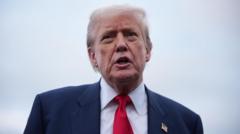

In a significant escalation of trade tensions, United States President Donald Trump has imposed an additional 25% tariff on imports from India, citing the country's continued purchase of Russian oil. This move, formalized through an executive order signed on Wednesday, August 6, 2025, effectively raises the total tariff on Indian goods to 50%.
Trump's decision is rooted in his administration's stance against countries that continue to trade with Russia, which the U.S. accuses of fueling the war against Ukraine. The executive order states that India's importation of Russian oil undermines U.S. efforts to counter Russia's harmful activities and poses an ongoing threat to U.S. national security and foreign policy. The U.S. President has long criticized New Delhi for "fuelling the (Russian) war machine".
The new tariff will take effect on August 27, 2025, giving businesses a 21-day window to adjust. Goods already in transit and cleared before September 17, 2025, will be exempt. This additional 25% tariff is on top of any existing duties, fees, taxes, and charges applicable to such imports.
This decision follows a prior 25% tariff imposed in late July and comes despite India's efforts to negotiate a trade deal with the U.S.. Negotiations between the two countries have reportedly stalled over disagreements regarding e-commerce regulations, digital data flows, and price controls on medical devices.
The Indian government has reacted strongly, accusing the U.S. and the European Union of double standards. New Delhi argues that these Western powers continue to import substantial volumes of goods, including energy, from Russia while simultaneously punishing India for doing the same. India's Ministry of External Affairs has stated that the targeting of India is unjustified and unreasonable, and that India will take all necessary measures to safeguard its national interests and economic security.
Despite the pressure, India has remained defiant, asserting its right to protect its national interests by continuing to purchase Russian oil. Government officials have signaled that they will not instruct refiners to halt Russian crude purchases.
Some experts suggest that the U.S. initially encouraged India to buy Russian oil to maintain stability in the global energy market and keep prices in check. In May 2024, the then U.S. Ambassador to India, Eric Garcetti, stated that India's purchase of Russian oil was actually the design of the policy because, as a commodity, the U.S. didn't want oil prices going up.
The implications of this tariff hike for the Indian economy could be significant. An internal assessment by the Ministry of Commerce and Industry indicates that a 25% tariff could impact approximately 10% of India's exports. Economists estimate that such a tariff could cut India's gross domestic product growth by 0.3 percentage points, with further penalties potentially curbing growth even more. Sectors like gems and jewelry, and textiles, are expected to be particularly affected.
The move has also drawn criticism from within India, with opposition leaders questioning the Modi government's previously friendly relationship with President Trump.
This latest development marks a significant strain on U.S.-India relations, potentially undoing years of growing strategic partnership. Experts suggest that bilateral relations are on a slippery slope, with the absence of a trade deal exacerbating the situation. It remains to be seen how both nations will navigate this challenging period and whether a resolution can be reached to de-escalate trade tensions.